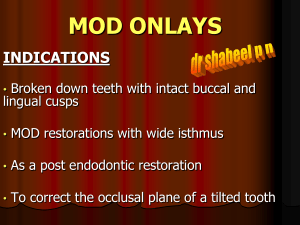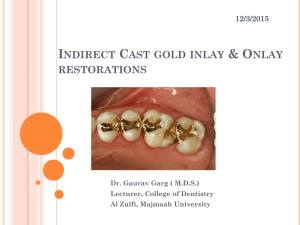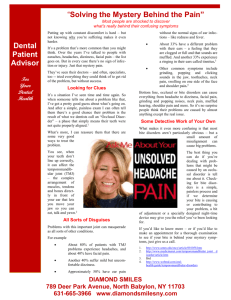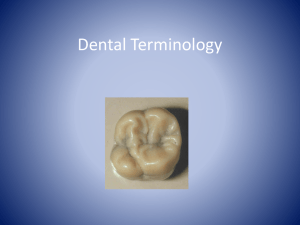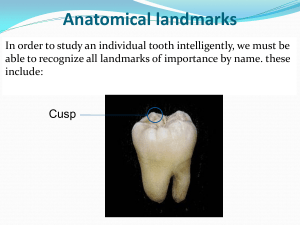onlaypreparations-151031163531-lva1-app6891
advertisement
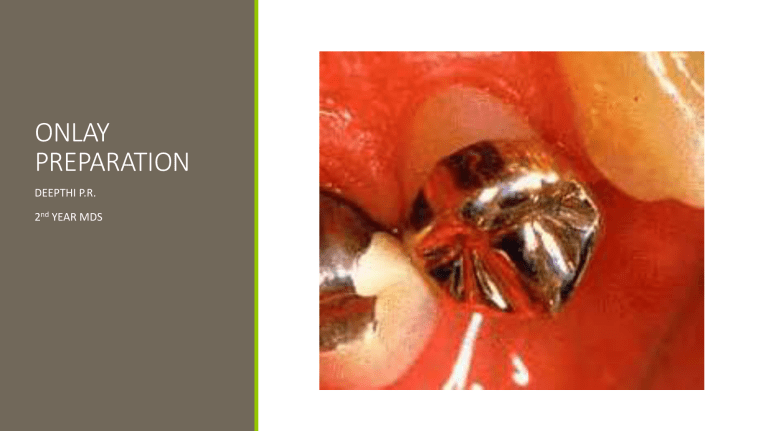
ONLAY PREPARATION DEEPTHI P.R. 2nd YEAR MDS MOD ONLAY An indirect restoration, which is partly intracoronal and partly extracoronal that covers all the cusps of a posterior tooth Partly intracoronal, partly extracoronal: Cuspal protection- main feature Modification of Cass II inlay Utilizes intracoronal retention Occlusal coverage: partial veneer extracoronal restoration Inlay: Wedge- like retention Outward pressure from the centre of the restoration: trying in, cementation & under occlusal forces Wedge like inlay increases risk of facture without protecting undermined cusps No reinforcement of tooth structure More protective restoration Forces dissipated: non destructive to the tooth structure Protection from occlusal forces: veneer of casting alloy over the occlusal surface Craig et al. Superiority of MOD onlay in protecting teeth from stress Ward (1926) , Mondelli et al. (1980)- isthmus width greater than one half the intercuspal distance: restored using overlay Reduction in premolar fracture resistance- Mondelli et al • Class I isthmus- 11% to 52% • Proximo occlusal- 17% to 57% • MOD- 36% to 61% MOD inlays: cracks at 40 to 50 degrees apically from the corner of the cavity preparation Onlays distribute forces over a wide area and reduce potential for breakage Stress analysis – Farah et al. 1977 Stress producing potential in an ordinary inlay Stress producing potential in an inlay with overextended bevel Stress producing potential in an inlay that is too wide Stress analysis – Farah et al. 1977 The use of an onlay keeps stresses at a low level Creates no hazard to the remaining tooth structure INDICATIONS Cuspal protection is to be considered- if the width of the lesion is 1/3 to ½ the intercuspal distance Cuspal protection is mandatory- width of the lesion exceeds ½ the intercuspal distance Length: width ratio of the cusp is more than 1:1; but not exceeding 2:1- Cuspal protection is to be considered Length: width ratio of the cusp is more than 2:1- Cuspal protection is mandatory When there is a need to change the dimension, shape and interrelationship of the occluding tooth surfaces Abutment teeth for RPD & fixed prostheses Ideal supporting restoration for remaining tooth structure, combined with conservative tooth involvement When wear facets that exceed the cusp tips & triangular ridge crests facially/ lingually are to be included PREPARATION FOR CLASS I, II & SOME CLASS III ALLOYS GENERAL SHAPE Dovetailed internally and follow cuspal anatomy externally Proximally: Box shaped/ cone shaped Capping of the functional and shoeing of the non- functional cusps “Capping” refers to the complete coverage of the cusp/ cusps of a tooth with sufficient extension of the bevel onto the buccal and lingual surfaces of the tooth to carry the margins of the restoration into areas where stresses cannot be brought to bear directly into them*. “ Shoeing” refers to a veneer coverage of the cusp of a tooth with only slight finishing bevel on the crest of the cusp. The bevel is established either at right angles to the long axis of the tooth or in a slight reverse direction *MOD INLAY & ONLAY PREPARATIONS. WENKU.BAIDU.COM PREPARATION FOR CLASS I, II & SOME CLASS III ALLOYS LOCATION OF MARGINS Occluso-facio-lingual portion- Capped side Facial & lingual margins: facial & lingual surface on the functional side where the cusps are capped Located gingivally enough to avoid contact with the opposing tooth in centric & eccentric movements Margins located so as to encompass all cuspal elements ¼ to 1/3 of facial & lingual surfaces PREPARATION FOR CLASS I, II & SOME CLASS III ALLOYS Occluso-facio-lingual portion- Gingivally Margins should include all facial/ lingual grooves Parallel the contour of cusp tips & crests of marginal ridges Increase in surface area & interlocking from uneven marginal termination – aids retention Conserves tooth structure PREPARATION FOR CLASS I, II & SOME CLASS III ALLOYS Occluso-facio-lingual portion- Shoed side Facial/ lingual margin will be located just gingival to the tip & ridge crests of the involved cusps & away from the occlusal contact Margins should follow the contour of the cusp tips & ridge crests Proximal portion Proximal margins will be in the exact location as inlays with modifications Secondary flare given in all cases PREPARATION FOR CLASS I, II & SOME CLASS III ALLOYS INTERNAL ANATOMY Occluso- facio-lingual portion Pulpal floor- as described for inlay, but deeper & at different levels THE FACIAL/ LINGUAL WALL ON THE CAPPED SIDE: Wall proper Occlusal bevel Table Counterbevel THE FACIAL/ LINGUAL WALL ON THE CAPPED SIDE Wall proper Intracoronal portion of the wall At least half of the vertical height of the wall Completely in dentin Slightly tapered from the opposing “wall proper” by 2- 5 degrees Makes a definite angle with the pulpal floor THE FACIAL/ LINGUAL WALL ON THE CAPPED SIDE Occlusal bevel Intracoronal portion of the wall At least 1/3 the total wall height Hollow- ground long bevel following with a standard angulation paralleling the cusp’s occlusal inclined planes 30 to 45 degrees from the long axis of the crown & approx. the same angulation as the wall proper Relieved at least 1 mm from the opposing cuspal elements THE FACIAL/ LINGUAL WALL ON THE CAPPED SIDE Occlusal bevel Two hollow ground bevels from the occlusally- one directed occluso mesially & one occlusodistally following the direction of the occlusal inclined planes Gives the bulk for the restorations at the inclined planes Increased surface area of contact between the teeth & the cast help to distribute forces physiologically on underlying tooth structures Help to guide the cast with one specific relation with the preparation surface Increase the immobilization of the restoration THE FACIAL/ LINGUAL WALL ON THE CAPPED SIDE Table Transitional area between the intracoronal & extracoronal parts of the preparation It can be partly in dentin/ enamel : relieved from opposing cusps by at least 1.5 mm in both static & functional contacts Major resistance form: flat Following cuspal anatomy in mesio- distal directions- 3 on each cusp: increase surface area provide more locking retention conserve tooth structure physiological distribution of occlusal loads THE FACIAL/ LINGUAL WALL ON THE CAPPED SIDE Counterbevel Extracoronal feature Formed in areas of enamel & dentin- maybe completely in either Relieved from opposing cuspal elements by at least 1 mm in both static & functional occlusal contact Hollow- ground, inclined away from the intracoronal parts gingivally- facially or lingually Each facial/ lingual inclined plane for a cusp Each cusp on capped side: four different hollow- ground bevels Embraces cuspal elements for retention &/ or support Angulation of the counterbevel Measured by the embracing angle: Angle between the bevel & the long axis of the crown- 30 to 70 degrees Factors determining the angulation Amount of indicated involvement for the facial/ lingual surface Amount of needed retention Type of cast alloy Angulation of the counterbevel Amount of indicated involvement for the facial/ lingual surface The more the desirable involvement is, the less will be the embracing angle to preserve tooth structure Amount of needed retention The shorter the preparation walls, the less will be the embracing angle with the long axis Maybe parallel to the intracoronal wall proper Type of cast alloy the less the castability, the greater will be the embracing angle Allows more bulk marginally Extent of the counterbevel Least standardized in this part of the preparation Additional determining factors other than those affecting the angulation: Location of occluding contacts Surface defects, grooves, pits, wear facets, decalcification Extent of the counterbevel Degree of needed embracing of the cuspal elements according to the future function of the restoration The need for changing the facial/ lingual contour of the tooth, especially its occlusal part The need for retention, especially with shortened axial items in the preparation The relation of preparation margins to the height of contour THE FACIAL/ LINGUAL WALL ON THE CAPPED SIDE The junction between the four different parts of the capped side should be definite, but slightly rounded Improve reproducibility Prevent stress concentration FACIAL/ LINGUAL WALL ON THE SHOED PART Formed of three parts: The “ wall proper” The occlusal bevel Similar to and reciprocating with that on the capped side The “ shoe” Likened to table on the capped side, but relieved in lesser dimension Most of the time- enamel Functions similar as table Shoe When it ends in acute angled tooth structure, leaving frail enamel: partial bevel- 4th plane Bevel inclines away from the cavity preparation- facially or lingually- gingivally following cuspal anatomy Also given- when the shoe cannot properly continue as a proximal flare Shoe avoided: for esthetic reasons, as its margins might terminate facially Similar to the capped side: the junction between the components- definite, but rounded PROXIMAL PORTION Very similar to that of inlays Wall proper & primary flare Secondary flare with the flexible angulation is an integral feature MODIFICATIONS FOR CLASS IV & SOME CLASS III ALLOYS Greater occlusal reduction to accommodate bulkier cast material All circumferential tie features are hollow ground All cusps capped, rather than shoed The above modifications cause shortening of walls occluso-apically & axio-proximally: maximum parallelism strived for MODIFICATIONS FOR CLASS IV & SOME CLASS III ALLOYS Avoid any small/ complicated internal/ external details- boxes Concavity of hollow ground bevels- include both enamel & dentin Secondary flares: deeper & more extensive MODIFICATIONS FOR CLASS V MATERIALS Cuspal protection: Capping only Three distinct planes for the capped cusps: - Exaggerated hollow- ground bevel extending from the pulpal floor to the table - table - Exaggerated hollow- ground bevel extending from the table to the facial/ lingual termination of the preparation Increased gingival extension to improve retention Embracing angle of the counter bevel more acute than that for the alloys MODIFICATIONS FOR CLASS V MATERIALS More occlusal reduction for greater bulk of the material Gingival, buccal & lingua walls of the proximal portion- very similar to preparation for cast ceramic inlay Usually deeper than preparations for Class I & II alloys , due to the frequent absence of boxedup internal portions Parallelism strived for in all walls due to the loss of retention owing to the exaggerated hollow ground bevels, increased occlusal reduction & limited dimensions of the proximal preparation features Avoid reverse secondary flares MODIFICATIONS FOR CLASS V MATERIALS Extreme occlusal involvement bucco- lingually: three planes of a capped cusp- minimal selfresistance Similar to Design 6 for Class II amalgam- cap is formed of two planes Wall proper & flat table terminating in a right- angled cavosurface margin The junctions between the walls, pulpal floor & table should be rounded Facial/ lingual margin ends in middle/ occlusal 3rd of that surface or in dentin Margins will not end in a concavity like a groove The internal walls do not need cuspal bracing for retention Remaining cuspal elements will not need reinforcing Steps in the Preparation of an MOD Onlay Planar Occlusal Reduction- Round end tapered diamond & NO. 171 Bur Planar Occlusal Reduction Depth- orientation grooves on the occlusal surface with the round-end tapered diamond One along the crest of each triangular ridge & one in each major developmental groove Planar Occlusal Reduction Occlusal reduction & depth orientation grooves- 1.5mm deep on functional cusp & 1mm deep over most of the nonfunctional cusp Maxillary tooth- nonfunctional facial cusp highly visible & care should be taken not to overcut the facio-occlusal extension Depth of the orientation grooves & the occlusal reduction itself – approximately 0.5mm in depth at the facio- occlusal line angle Planar Occlusal Reduction Remove the tooth structure remaining between the depth orientation grooves with the roundend tapered diamond Reduction should follow the original contours of the cusp, reproducing the basic geometric inclined planes to the occlusal surface in the process Corrugated multiplanar design: -Creates space for a uniform bulk of metal - Adds more strength to the restoration Functional Cusp Bevel: Round end tapered diamond & No. 171 bur Functional Cusp Bevel Depth- orientation cuts are made on the outward facing inclines of the functional cusp 1.5mm deep at the cusp tip & fade out along the line that will location of the occlusal shoulder later mark the Functional Cusp Bevel Reduction is completed by removal of tooth structure between the grooves The bevel approximates the angle of the cuspal inclines in the opposing arch Extends around the central groove on the mesial & distal surfaces of the tooth Final extension can be delayed until the proximal boxes have been instrumented Functional Cusp Bevel The planes of the occlusal reduction & functional cusp bevel: smoothed with No. 171 tapered fissure bur Inclined planes: well- defines, but with no sharp line or point angles Smooth surface of occlusal reduction: removes defects that might later interfere with the complete seating of the restoration Check for Occlusal reduction Visual inspection- important Limited to the facial half o the occlusal surface Lingual cusps: verified with utility wax/ thickness gauge Occlusal shoulder: No.171 Bur Occlusal shoulder Cut using a No. 171 bur, following the termination line of the functional cusp bevel On the axial surface of the functional cusp 1mm wide shoulder, extends from the central groove on one proximal surface to the central groove on the other proximal surface Provides space for a bulk of metal to reinforce the occlusal margin on the functional cusp Occlusal shoulder Chamfer/ occlusal shoulder: occlusal finish line Ensures acute edge in the restoration margin, with a nearby bulk of metal Shoulder with bevel: easier to prepare properly: advised for a novice Isthmus: No.170 bur Isthmus If there was no existing restoration to be removed: isthmus is made at this point 1mm shallower than the isthmus of inlay; occlusal surface already reduced Smooth walled opposing facial & lingual walls with minimum taper Provides 1/5 of the retention & a great deal of resistance Proximal box: No. 169L & No. 170 burs Proximal box Preparation begun: No. 170 bur Relatively intact proximal surface: 169L bur- smaller & more easily kept away from the adjacent proximal surface Barely break contact with the adjacent tooth : Mesial surface 1mm wide gingival floor 169L bur: accentuate the facioaxial & linguoaxial line angles Proximal box Repeat the process with the distal box The facial extensions can be less conservative Proximal box Facial & lingual walls, line angles: 169 bur Very little hand instrumentation of the angles needed Proximal box Bur leaned slightly to the center of the tooth & to the facial / lingual side- form the walls of the boxes Ensures occlusal divergence of the facial & lingual walls, occlusal convergence of the axial walls Proximal box Width of the proximal contact areas with the adjacent tooth checked Proximal flares started only once the boxes are finished Proximal box 1mm wide enamel chisel; Binangle chisel/ hatchet: pane the facial & lingual walls Walls: perpendicular to the direction of oblique/ rotating forces: resistance to the restoration Planing Horizontal Surfaces: No. 957 bur Planing Horizontal Surfaces Smooth the pulpal floor of the isthmus that joins the proximal boxes Occlusal shoulder of the functional cusp bevel 1mm wide Planing Horizontal Surfaces Gingival floors of the proximal boxes are planed the last Improves the resistance of the finished onlay to displacement when compressive occlusal forces occur on the restoration Proximal Flares: Flame diamond & Flame bur Proximal Flares Started with tip of a flame shaped diamond from within the box Allows the instrument to be inserted into the restricted embrasure space without injuring the adjacent tooth Proximal Flares Wide enamel hatchet : 1.5 to 2 mm used to shape the mesiofacial flare where esthetic considerations are important Sandpaper disk Sharp instrument: smooth, unmarred flare & finish line Under rubber dam isolation Careful: soft tissues Gingival bevel: Flame diamond & Flame bur Gingival bevel Flame shaped diamond: 0.5 to 0.7 mm wide bevel along the entire gingival floor Bend into the flares on the facial & lingual walls of the box without any undercut Lean the diamond over into the proximal box: avoids excessively long/ obtuse bevel Rounding of the proximo- occlusal in the angle: acceptable Gingival bevel Flares & bevels: reinstrumented with the flame shaped carbide finishing bur Smooth the flares & bevels Produce a sharp, distinct finish line: facilitate the fabrication of a well- fitting restoration Facial & Lingual bevels: Flame diamond & No. 170 bur Facial & Lingual bevels Occlusal finishing bevel: facial cusp with No. 170 bur Perpendicular to the long axis of the tooth: approx. 0.5 mm wide If bur leaned over to the faciogingival: wider & compromises esthetics Facial & Lingual bevels Round the bevel over onto the facial flares Outer edge of the occlusal bevel, continuous with the outer edge of the facial flare: smooth, unbroken finish line in the transitional area Sharp angle: Negative angle in the wax pattern- unfinishable gap in the casting margin Angle between the occlusal reduction & the flares also rounded over Avoid sharp projections- later interfere with the complete seating of the final restoration Facial & Lingual bevels 0.5mm bevel on the occlusal shoulder: blend smoothly with the lingual flares at their junction Not extended too far gingivally Wide & thin wax pattern- Incomplete casting Angle between the functional cusp bevel & the flares also rounded Completed MOD Onlay Preparation on Maxillary Premolar MODIFICATIONS IN ONLAY TOOTH PREPARATIONS Facial/ lingual surface groove extension Inclusion of Portions of the Facial and Lingual Smooth Surfaces Affected by Caries, Fractured Cusps, or Other Injury Enhancement of Resistance and Retention Forms Modifications for Esthetics on Maxillary Premolars and First Molars Endodontically Treated Teeth Restoring the Occlusal Plane of a Tilted Molar Facial or Lingual Surface Groove Extension A facial surface fissure (mandibular molar) / lingual surface fissure (maxillary molar) : similarly as in inlay preparation. This extension is sometimes indicated to provide additional retention form even though the groove is not faulty. Inclusion of Portions of the Facial and Lingual Smooth Surfaces Affected by Caries, Fractured Cusps, or Other Injury. Shallow to moderate lesions on facial surfaces are included similar to inlay preparation Fractured mesiolingual cusp of a mandibular molar Use a No. 271 carbide bur to cut a shoulder perpendicular to occlusal force by extending the proximal gingival floor (adjacent to the fracture) to include the affected surface. Shoulder partially provides the desired resistance form by being perpendicular to gingivally directed occlusal force. Use this instrument also to create a vertical wall in the remaining lingual enamel Inclusion of Portions of the Facial and Lingual Smooth Surfaces Affected by Caries, Fractured Cusps, or Other Injury. Short clinical crown: proximal grooves for additional retention with the No. 169L bur. Linguogingival and lingual margins are beveled with the flame-shaped, fine-grit diamond instrument to provide: 30-degree metal at the gingival margin These two bevels should blend together 40-degree metal along the lingual margin Enhancement of Resistance and Retention Forms (1) improve retention form (2) resist forces normally opposed by the missing mesiolingual wall (3) help protect the restored tooth from further fracture injury Grossly weakened by caries or previous filling material prone to fracture under occlusal loads Cusp capping augmented by skirts, collars, or facial (lingual) surface groove extensions Such onlays distribute occlusal forces over most or all of the tooth Enhancement of Resistance and Retention Forms The lingual "skirt" / "collar" preparation/ the lingual surface groove extension on a maxillary molar protect the facial cusps from fracture The facial skirt extension(s)/ the facial collar preparation/ the facial surface groove extension on a mandibular molar protect the lingual cusp(s) from fracture Skirt Preparation Thin extensions of the facial or lingual proximal margins of the cast metal onlay that extend from the primary flare to a termination just past the transitional line angle of the tooth. A skirt extension is a conservative method of improving both the retention & resistance forms Relatively atraumatic to the health of the tooth: removes very little (if any) dentin Usually the skirt extensions are prepared entirely in enamel Lingual wall missing: skirt extension on the facial wall Skirt Preparation Facial wall missing: skirt extension of the lingual surface When both the lingual and facial walls of a proximal boxing are inadequate: skirt extensions on both the respective lingual & facial margins The addition of properly prepared skirts to three of four line angles of the tooth virtually eliminates the chance of postrestorative fracture of the tooth because the skirting onlay is primarily an extracoronal restoration that encompasses and braces the tooth against forces that might otherwise split the tooth The skirting onlay is often used successfully for many teeth that exhibit the split-tooth syndrome. Other indications- Skirt The proximal surface contour & contact are to be extended more than the normal dimension to develop a proximal contact. When improving the occlusal plane of a mesially tilted molar by a cusp capping onlay, reshaping the mesial surface to a satisfactory contour and contact Splinting posterior teeth together with onlays Ease of soldering the connector(s) and finishing of the proximal margins is increased Disadvantage: Increases the display of metal on the facial & lingual surfaces - avoided on the mesiofacial margin of maxillary premolars and first molars Preparation of Skirt Slender, flame-shaped, fine-grit diamond instrument Follows the completion of the proximal gingival bevel & primary flares At the same time that the gingival bevel is placed, working from the lingual toward the facial or vice versa The long axis of the instrument parallel to the line of draw The rotating instrument into the tooth to create a definite vertical margin, just beyond the line angle of the tooth, providing at the same time a 140-degree cavosurface enamel angle (40degree metal angle) Preparation of Skirt Extending into the gingival third of the anatomic crown is usually necessary for effective resistance form The gingival margin of the skirt extension is occlusal to the position of the gingival bevel of the proximal box Preparation of Skirt Less than one half of the tip diameter of the flame shaped diamond used top avoid creating a ledge at the gingival margin Blending with the primary flare & proximal gingival margin: Translate instrument from entrance cut to proximal surface Preparation of Skirt Be sure not to overreduce the line angle of the tooth when preparing skirt extensions The bracing effect of the skirt will be diminished Holding the diamond instrument at the same angle that was used for preparing the counterbevel, round the junction between the skirt and the counterbevel Slightly round any sharp angles that remain after preparation of the skirt to avoid difficulties in subsequent steps of completing the restoration. Collar Preparation To increase the retention and resistance forms when preparing a weakened tooth for a MOD onlay capping all cusps, a facial or lingual "collar," or both, may be provided No. 271 carbide bur at high speed parallel to the line of draw to prepare a 0.8-mm deep shoulder around the lingual (or facial) surface to provide for a collar about 2 to 3 mm high occlusogingivally (see Fig. 20-31, A and B). Collar Preparation To provide for a uniform thickness of metal, the occlusal 1 mm of this reduction should be prepared to follow the original contour of the tooth & should round any undesirable sharp line angle formed by the union of the prepared lingual and occlusal surfaces. Lightly bevel the gingival margin of the shoulder with the flame-shaped, fine-grit diamond instrument to result in a 30-degree metal angle at the margin Slot Preparation I. Mandibular second molar that has no molar posterior to it and requires a MO onlay restoration capping all of the cusps After cusp reduction, the vertical walls of the occlusal step portion of the preparation have been reduced so as to provide very little retention form. Distal slot: (1) more conserving of tooth structure and of strength of the tooth crown (2) the linear extent of marginal outline is less Slot Preparation Use a No. 169L carbide bur whose long axis should parallel the line of draw The slot is cut in dentin so that if it were to be extended gingivally, it would pass midway between the pulp and the DEJ so as to avoid: (1) exposure of the pulp (2) removal of the dentin supporting the distal enamel (3) perforation of the distal surface of the tooth at the gingival termination of the slot Slot Preparation Approx. dimensions of slot (1) mesiodistally, the width (diameter) of the bur (2) faciolingually, 2 mm and (3) depth, 2 mm gingival of the normally positioned pulpal wall. To be effective, the mesial wall of the slot must be in sound dentin Slot Preparation II. Maxillary first premolar requires a DO onlay restoration capping the cusps Mesially positioned 1.5mm wide faciolingually slot The mesial occlusal marginal outline in this preparation should be distal of the height of the mesial marginal ridge Modifications for Esthetics on Maxillary Premolars and First Molars On the facial cusps of maxillary premolars & on the mesiofacial cusp of the maxillary first molar, the occlusal reduction should only be 0.75 to 1 mm on the facial cusp ridge to decrease the display of metal Increase progressively to 1.5 mm toward the center of the tooth to help provide rigidity to the capping metal. These cusps do not receive a counterbevel but are "stubbed" or blunted by the application of a sandpaper disc or the fine-grit diamond instrument held at a right angle to the facial surface The surface created by this blunting should be approximately 0.5 mm in width. Modifications for Esthetics on Maxillary Premolars and First Molars The mesiofacial margin is minimally extended facially of contact to such a position that the margin is barely visible from a facial viewing: Secondary flare is omitted, Wall and margin are developed with a chisel or enamel hatchet Final smoothing with the fine grit paper disc is recommended when access permits. The cavosurface margin should result in a gold angle of 40 to 50 degrees, if possible. When more than ideal extension of the mesiofacial margin is necessary: place a composite insert at this margin When preparing the mesiofacial margin, no attempt is made to develop a straight mesiofacial wall past the point of ideal extension After caries excavation a glass-ionomer cement base is inserted to temporarily form the missing portion of the wall The cement is contoured to ideal form, and the preparation continue, terminating the mesiofacial onlay margin in ideal position in the cement Following cementation, remove (with small round burs) the glass-ionomer cement to a depth of 1 mm for a composite insert. Small undercuts should be prepared in the wall formed by the cast metal onlay After beveling enamel cavosurface, preparing a gingival retention groove where, and if, enamel is thin or missing, insert the composite veneer Endodontically Treated Teeth Facial & lingual surfaces of an endodontically treated tooth are sound, it is more conservative for the health of the facial and lingual gingival tissues not to prepare the tooth for a full crown but for a MOD onlay future tooth fracture Such features include skirt extensions and collar preparations Onlay more of an extracoronal restoration that encompasses the tooth, such that the tooth is better able to resist lateral forces that might otherwise fracture the tooth Pulp chamber should be excavated to the chamber floor and sometimes into the canals (1 to 2 mm), & an amalgam foundation placed Endodontically treated premolar for an onlay, the canal is usually prepared for a metal post Tooth resist forces that might otherwise cause a horizontal fracture of the entire tooth crown from the root The post should extend roughly two thirds the length of the root & should terminate, leaving at least 3 mm of the root canal filling material at the apical portion of the root. Restoring the Occlusal Plane of a Tilted Molar When the unprepared occlusal surface (mesial portion) is less than the desired occlusal plane, a corresponding decrease in occlusal surface reduction The counterbevels on the latter surfaces often should be extended gingivally more than usual When the unprepared occlusal surface (mesial portion) is less than the desired occlusal plane, a corresponding decrease in occlusal surface reduction is indicated. Often the mesiofacial and mesiolingual margins (on the "submerged" proximal surface) should be well extended onto the respective facial and lingual surfaces to help in recontouring the mesial surface to desirable proximal surface contour and contact Minimal loss of tooth structure by preparing facial and lingual skirt extensions on the respective proximal margins CONCLUSION Onlays: viable treatment option Overcomes many shortcomings of inlay restorations Improved resistance form: bracing tooth structure Relevant in the occlusion- centred approach of restorative dentistry rather than the one which is solely tooth- oriented Prudent use : Valuable alternative for full coverage restorations in many situations Thank you..
